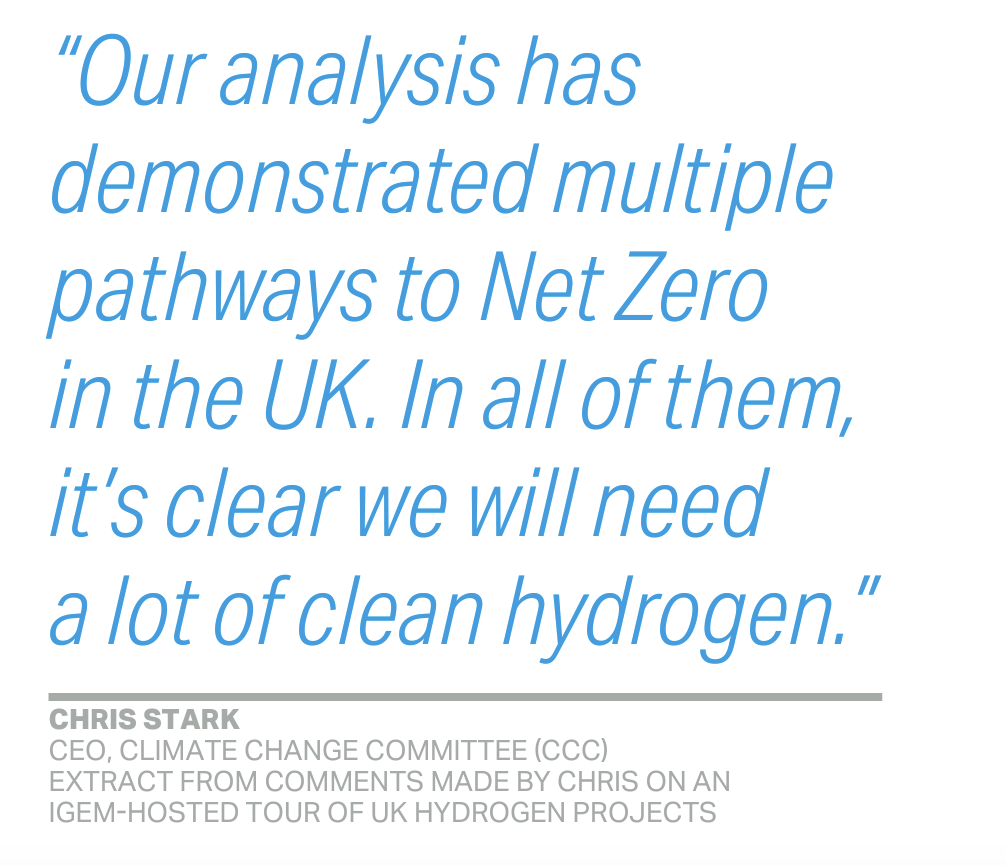In order to prevent the worst effects of climate change, there is a global target to become net zero by 2050. Net zero refers to a state in which greenhouse gases going into the atmosphere (the drivers of climate change) are balanced out by their removal from the atmosphere. In the last few weeks, leaders in the gas energy sector have made a pledge to commit to using hydrogen to provide 20-35% of the UK’s energy demands by 2050. These pledges appear in an eagerly awaited report released by the Energy Networks Association – ‘A Hydrogen Vision for the UK.’

The Five Pledges:
As part of this commitment to use hydrogen, five pledges have been created:
1. Play a lead role in delivering against the UK’s hydrogen ambitions
2. Conduct further research and testing in an open and transparent manner
3. Engage with consumers across our networks on delivering Net Zero
4. Work collaboratively with all stakeholders across the sector using a ‘whole systems’ approach
5. Invest in both developing a skilled workforce for the future and a UK supply chain
This pledge has been signed by:
Graham Edwards – Chief Executive Officer Wales & West Utilities
Mark Horsley – Chief Executive Officer Northern Gas Networks
Mark Wild – Chief Executive Officer SGN
Jon Butterworth – Chief Executive Officer National Gas
Paddy Larkin – Chief Executive Officer Mutual Energy
Steve Fraser – Chief Executive Officer Cadent Gas
Energy Networks Association & Infrastructure Development
This report, A Hydrogen Vision for the UK, released by the Energy Networks Association, outlines how the UK can move away from fossil fuels and includes the above five pledges. It also provides detailed roadmaps looking at the growth and development of the UK hydrogen infrastructure over the next three decades up to 2050.
A range of low-carbon technologies to clean up and decarbonise our energy system is needed, including nuclear, biofuels etc. While some experts say hydrogen is not realistic as an energy source, it’s important to understand that without hydrogen in the energy mix, net zero will be very unlikely to happen. Including hydrogen in the mix is a critical necessity.

New pipes and general infrastructural development is required, along with repurposing and developing current gas pipes to safely and reliably transport the hydrogen around the network.
The need for new facilities to store hydrogen needs to be considered, as are the new appliances homes and businesses need to turn hydrogen into renewable energy.
Over the coming years, huge developments in a wide range of sectors will be taking place. An incredible £6.8bn is reportedly ready to be invested by gas networks by the end of the decade in various hydrogen-focused projects.
Mapping Out Projected Progress – as outlined in the report – A Hydrogen Vision for the UK:
2030 – UK Government: 10 GW of low carbon hydrogen production (with at least 5 GW of this from electrolytic production) Scottish Govt: 5 GW hydrogen production 50 GW offshore wind Four CCUS Industrial Clusters Hydrogen Town, following delivery of a Hydrogen Village.
Benefits – Hydrogen will be available for consumers in industrial clusters, with co-located supply and demand that will be supported by local dedicated [private] networks and storage. In these areas, businesses are able to benefit from ‘first-mover’ status in the pioneering of hydrogen-powered products
2035 – Full decarbonisation of the power sector National emissions will be reduced by 78% versus 1990 levels, in line with the Sixth Carbon Budget, including emissions from shipping and aviation.
Benefits – The delivery of a national backbone linking supply-to-demand network conversion will mean hydrogen is available to a wider range of consumers, including households and power generators. A focus on repurposing the existing assets will reduce the costs of transitioning from natural gas to hydrogen for consumers.
2040 – The UK becomes a net energy exporter
Benefits – Consumers beyond industrial clusters and urban areas will be able to switch to hydrogen if they wish. Hydrogen export potential in Scotland, Northern Ireland and Wales, due to onshore and offshore wind potential, begins to be realised – creating additional economic opportunities.
2045 – Scotland achieves Net Zero, including a 25 GW hydrogen production target. Scotland possibly exporting up to 94 TWh of hydrogen to the UK and other European markets by 2045.
Benefits – Consumers in all regions can access hydrogen by the mid-2040s. Areas, where there is a shift towards low-carbon hydrogen will see the extensive conversion of pipelines at all levels, extending the life of existing infrastructure and helping to keep the cost of decarbonisation low for consumers.
2050 – UK to achieve Net Zero Additional targets likely to emerge through future Governments.
Benefits – At the end of our mapping scenario, the use of hydrogen by consumers is widespread, providing low-carbon energy across the economy, providing choice to consumers and keeping businesses viable.








